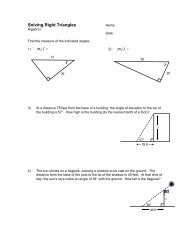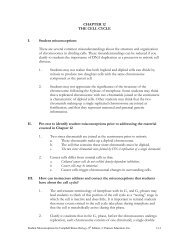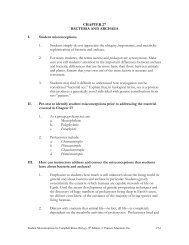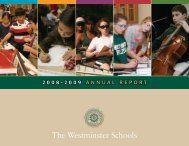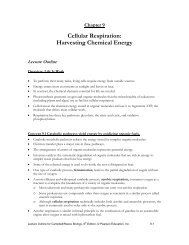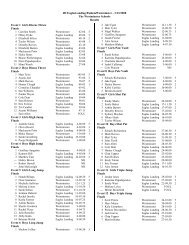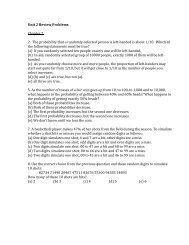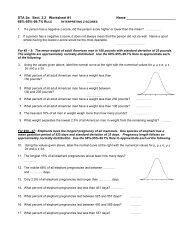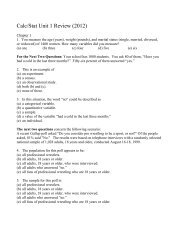CHAPTER 14 MENDEL AND THE GENE IDEA - Hancock High School
CHAPTER 14 MENDEL AND THE GENE IDEA - Hancock High School
CHAPTER 14 MENDEL AND THE GENE IDEA - Hancock High School
Create successful ePaper yourself
Turn your PDF publications into a flip-book with our unique Google optimized e-Paper software.
At present, little is understood about the genetic contribution to most multifactorial diseases.<br />
o The best public health strategy is education about relevant environmental factors and<br />
promotion of healthy behavior.<br />
Genetic Testing and Counseling<br />
A preventive approach to simple Mendelian disorders is sometimes possible.<br />
The risk that a particular genetic disorder will occur can sometimes be assessed before a child is<br />
conceived or early in pregnancy.<br />
Many hospitals have genetic counselors to provide information to prospective parents who are<br />
concerned about a family history of a specific disease.<br />
Counseling Based on Mendelian Genetics and Probability Rules<br />
Consider a hypothetical couple, John and Carol, who are planning to have their first child.<br />
Both John and Carol had brothers who died of the same recessive disease.<br />
o John, Carol, and their parents do not have the disease.<br />
o Their parents must have been carriers (Aa × Aa).<br />
o John and Carol each have a 2/3 chance of being carriers and a 1/3 chance of being<br />
homozygous dominant.<br />
o The probability that their first child will have the disease is 2/3 (chance that John is a carrier)<br />
× 2/3 (chance that Carol is a carrier) × 1/4 (chance that the offspring of two carriers is<br />
homozygous recessive) = 1/9.<br />
o If their first child is born with the disease, we know that John and Carol’s genotype must be<br />
Aa and they are both carriers.<br />
o In that case, the chance that their next child will also have the disease is 1/4.<br />
Mendel’s laws are simply the rules of probability applied to heredity.<br />
o Because chance has no memory, the genotype of each child is unaffected by the genotypes<br />
of older siblings.<br />
o The chance that John and Carol’s first three children will have the disorder is 1/4 × 1/4 ×<br />
1/4 = 1/64.<br />
o Should that outcome happen, the likelihood that a fourth child will also have the disorder is<br />
still 1/4.<br />
Tests for Identifying Carriers<br />
Because most children with recessive disorders are born to parents with a normal phenotype, the<br />
key to assessing risk is identifying whether prospective parents are heterozygous carriers of the<br />
recessive trait.<br />
Recently developed tests for many disorders can distinguish normal phenotypes in heterozygotes<br />
from homozygous dominants.<br />
o These results allow individuals with a family history of a genetic disorder to make informed<br />
decisions about having children.<br />
o Issues of confidentiality, discrimination, and counseling may arise.<br />
Fetal Testing<br />
Lecture Outline for Campbell/Reece Biology, 8 th Edition, © Pearson Education, Inc. <strong>14</strong>-15




